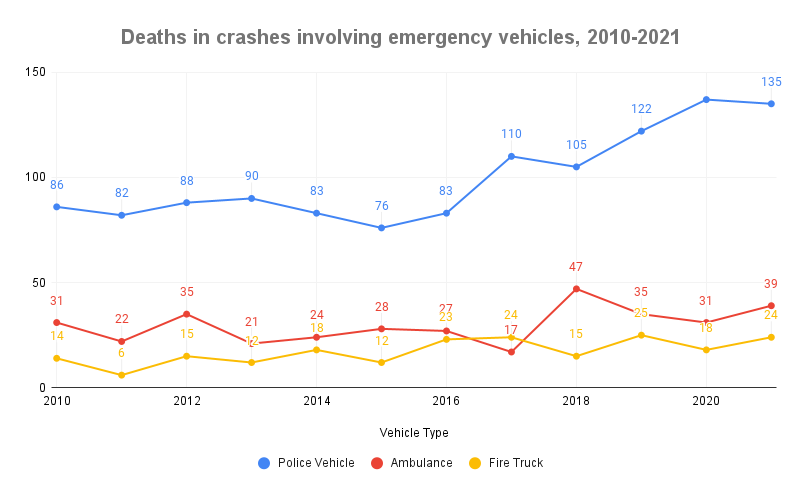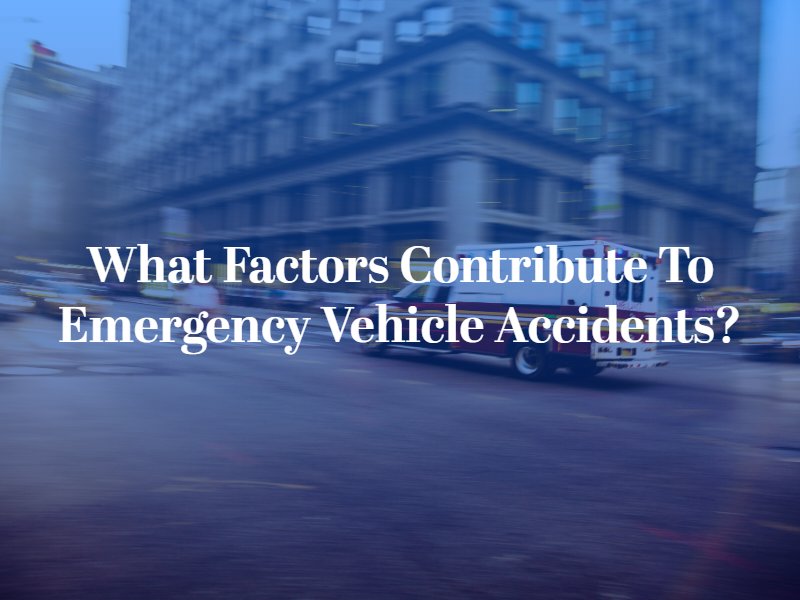Emergency Vehicle Accidents Statistics
Emergency vehicles such as ambulances, fire trucks, and police cars play a crucial role in responding to emergencies and saving lives in the United States.
However, these vehicles are also involved in car crashes that can lead to injuries, fatalities, and property damage. Understanding the statistics and factors contributing to emergency vehicle accidents is important for improving safety on our roads.
If you or a loved one has been affected by such an incident, consulting with a Chicago accident attorney can provide guidance and support in navigating the legal aspects of your case.
In this article, we will provide an overview of emergency vehicle accidents in the USA, including statistics, causes, and consequences, as well as prevention strategies to mitigate these incidents.
Number of Emergency Vehicle Accidents
Emergency vehicle accidents are a significant problem in the United States. According to a report released by the National Highway Traffic Safety Administration (NHTSA) in 2011 that analyzed traffic crash data for the period 1992 – 2011, there were an annual estimated mean of 4,500 motor vehicle traffic crashes involving an ambulance.
The most recent report from the National Safety Council found that almost 200 people died in crashes involving emergency vehicles in 2021 alone.

Type of Emergency Vehicle Accidents
Emergency vehicle accidents can involve any type of emergency vehicle, but the most common types are ambulance, firetruck, and police car accidents. Ambulance accidents account for the highest percentage of emergency vehicle crashes, followed by fire truck accidents and police car accidents.
Ambulance Accidents
Ambulances are involved in a significant number of emergency vehicle accidents, often due to the high speeds at which they travel to reach the scene of an emergency.
Ambulance accidents can be particularly dangerous because they often involve patients who are already injured or ill.
Fire Truck Accidents
Firetrucks are typically larger and heavier than other types of emergency vehicles, which can make them more difficult to maneuver in traffic. They are also often equipped with ladders and other equipment that can obstruct the driver’s view.
Police Car Accidents
Police car accidents can occur during high-speed chases, as well as during routine patrols. These accidents can be particularly dangerous because they often involve innocent bystanders who are not involved in the pursuit.
Causes of Emergency Vehicle Accidents
Emergency vehicle accidents can be caused by a variety of factors. The main factors normally are: human error, mechanical failure, and road conditions.
Human Error
Driver error is one of the most common causes of emergency vehicle accidents. This can include driving too fast for the conditions, failing to yield to other vehicles, and distracted driving.
Mechanical Failure
Mechanical failure can also contribute to emergency vehicle accidents. Issues with brakes, tires, and steering systems can all lead to accidents.
Road Conditions
Road conditions can also play a role in emergency vehicle accidents. Wet or icy roads, potholes, and other hazards can make it difficult for drivers to maintain control of their vehicles, even at slower speeds.
Consequences of Emergency Vehicle Accidents
Emergency vehicle accidents can have severe consequences, which include injuries and fatalities, property damage, and legal and financial ramifications.
Injuries and Fatalities
Emergency vehicles often operate at high speeds, which can result in severe injuries and fatalities in the event of a collision. Emergency responders are trained to prioritize the safety of patients and the public, but accidents can still occur due to various factors.
Property Damage
Emergency vehicle accidents can also result in significant property damage, including damage to other vehicles, structures, and infrastructure. The cost of repairing or replacing damaged property can be substantial.
Legal and Financial Consequences
Emergency vehicle accidents can also result in legal and financial consequences for the driver and the organization responsible for the vehicle. Victims of emergency vehicle accidents may pursue legal action to recover damages for medical expenses, lost wages, and other losses. In addition, emergency vehicle operators and organizations may face fines and other penalties for violating traffic laws or failing to follow safety protocols.
To mitigate these consequences, it is essential for emergency vehicle operators and organizations to prioritize safety through measures such as proper training, adherence to safety protocols, and the use of advanced vehicle technology. By taking these steps, emergency responders can help to prevent accidents and minimize the potential impact on individuals, property, and communities.

Factors Contributing to Emergency Vehicle Accidents
Several factors contribute to emergency vehicle accidents, including emergency vehicle driver training, response protocols and procedures, traffic and road conditions, and public awareness and education.
Emergency Vehicle Driver Training
Proper training for emergency vehicle drivers is essential to ensure safe and effective operation of emergency vehicles. This includes training on driving techniques, vehicle handling, and emergency response protocols. Ongoing training and education can help emergency vehicle operators to maintain their skills and stay up-to-date with the latest safety procedures.
Response Protocols and Procedures
Emergency response protocols and procedures provide guidance for emergency vehicle operators on how to respond to different types of emergencies. These protocols often include guidelines for speed, traffic laws, and coordination with other emergency responders. Effective protocols can help to minimize the risk of accidents and improve response times.
Traffic and Road Conditions
Traffic and road conditions can also contribute to emergency vehicle accidents. Congestion, construction, and poor road conditions can all increase the risk of collisions or other accidents. Emergency vehicle operators must be aware of these factors and adjust their driving accordingly to minimize the risk of accidents.
Public Awareness and Education
Public awareness and education can also play a role in preventing emergency vehicle accidents. Educating the public on the importance of yielding to emergency vehicles, as well as the potential risks associated with emergency vehicle operation, can help to improve safety on the roads. Additionally, raising awareness about emergency response protocols and procedures can help to reduce confusion and improve coordination between emergency responders and other road users.
By addressing these factors, emergency vehicle operators and organizations can help to reduce the risk of accidents and improve the overall safety of emergency response operations.
Prevention Strategies for Emergency Vehicle Accidents
There are several prevention strategies that can be implemented to reduce the risk of emergency vehicle accidents:
Improved Training and Education for Emergency Vehicle Drivers
Providing regular and ongoing training for emergency vehicle drivers can help to improve their skills and ensure that they are up-to-date with the latest safety procedures. Training can include driving techniques, vehicle handling, and emergency response protocols.
Enhanced Communication and Coordination between Emergency Vehicle Drivers and Other Road Users
Clear communication between emergency vehicle drivers and other road users is essential for safe and efficient emergency response operations. Effective communication protocols can help to minimize the risk of accidents and improve response times.
Advanced Vehicle Technology
Advances in vehicle technology, such as collision avoidance systems and automatic emergency braking, can also help to reduce the risk of emergency vehicle accidents. These technologies can help emergency vehicle drivers to avoid collisions and react more quickly to potential hazards.
Community Outreach and Education
Educating the public about the importance of yielding to emergency vehicles and the potential risks associated with emergency vehicle operation can also help to improve safety on the roads. Community outreach programs and public awareness campaigns can help to raise awareness about emergency response protocols and procedures, as well as promote safe driving practices.
By implementing these prevention strategies, emergency vehicle operators and organizations can help to reduce the risk of accidents and improve the safety of emergency response operations for both emergency vehicle operators and other road users.
Emergency vehicle accidents can have serious consequences, including injuries, fatalities, and property damage. In the USA, emergency vehicle accidents involving ambulances, fire trucks, and police cars are all too common and can be caused by a variety of factors such as human error, mechanical failure, and road conditions.
It is crucial to prevent these accidents to ensure the safety of emergency vehicle operators and other road users. Prevention strategies such as improved driver training, enhanced communication protocols, advanced vehicle technology, and community outreach and education can all help to reduce the risk of accidents and improve safety.
It is also imperative that emergency vehicle operators and organizations take action to implement these prevention strategies and continually assess and improve their emergency response protocols. By working together, we can ensure that emergency vehicle operations are safe and efficient, ultimately helping to save lives and prevent injuries.
